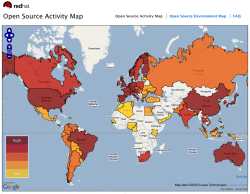Red Hat maps dispel some open source myths


That's one of the more surprising, and inescapable conclusions, I drew from checking out the Red Hat "open source maps" created by Georgia Tech. (Go Jackets.)
The maps are the outgrowth of a joint project called the Open Source Potential Index Project, headed by Tech professor Douglas Noonan. (Paul M.A. Baker Ph.D writes to say he did the heavy lifting.)
The maps were created by ranking the open source activity and environment in each of 75 countries. Here are some other conclusions:
- Brazil's activity level is higher than its actual support for the software.
- Russia's is just the opposite.
- Canada's environment for open source isn't great, but it is extremely active.
- China and India are not nearly as dominant as you think. Neither government has yet matched deeds to words.
If government rhetoric and claims of support can boost a national open source community then change is coming. A great experiment has begun and I hope the map is redone in a few years so we can visualize the results.
Check them out yourself. They're fun.